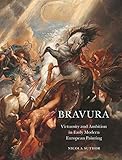Bravura : Virtuosity and Ambition in Early Modern European Painting / Nicola Suthor.
Material type: TextPublisher: Princeton, NJ : Princeton University Press, [2021]Copyright date: ©2021Description: 1 online resource (304 p.) : 89 color + 46 b/w illusContent type:
TextPublisher: Princeton, NJ : Princeton University Press, [2021]Copyright date: ©2021Description: 1 online resource (304 p.) : 89 color + 46 b/w illusContent type: - 9780691213439
- Painting -- Technique
- Painting, Late Renaissance
- ART / History / Renaissance
- Ambitious Form
- Beheading of John the Baptist
- Bernard Weinberg
- Cavaliere Mattia Preti
- Francisco Goya
- Francois Boucher
- Giambattista Piazzetta
- Giovannie Battista Armenini
- Giuseppe Cesari
- Hercules and Omphale
- History of Literary Criticism in the Italian Renaissance
- Il Bravo
- Il far presto
- Jean-Honore Fragonard
- Jupiter, Neptune, and Plato
- Las Hilanderas
- Luca Giordano
- Malle Babbe
- Marco Boschini
- Martyrdom of Saint Agatha
- Michael Cole
- Michael Polanyi
- Philip Sohm
- Pietro Testa
- Pittoresco
- Portraits de Fantaisie
- Raphael
- Royal Academy of England
- Royal Academy of France
- Self-Portrait with a Friend
- The Fall of Phaeton
- The Massacre of the Innocents
- Titian
- Vaghezza
- Vasari
- bravare
- diligenza
- ferocita
- fierezza
- franchezza
- prestezza
- sprezzatura
- 759.03 23
- ND170 .S88 2021
- online - DeGruyter
| Item type | Current library | Call number | URL | Status | Notes | Barcode | |
|---|---|---|---|---|---|---|---|
 eBook
eBook
|
Biblioteca "Angelicum" Pont. Univ. S.Tommaso d'Aquino Nuvola online | online - DeGruyter (Browse shelf(Opens below)) | Online access | Not for loan (Accesso limitato) | Accesso per gli utenti autorizzati / Access for authorized users | (dgr)9780691213439 |
Browsing Biblioteca "Angelicum" Pont. Univ. S.Tommaso d'Aquino shelves, Shelving location: Nuvola online Close shelf browser (Hides shelf browser)

|

|

|

|

|

|

|
||
| online - DeGruyter Goethe, Volume 9 : Wilhelm Meister's Apprenticeship / | online - DeGruyter Isaiah Berlin : An Interpretation of His Thought / | online - DeGruyter Chinese Primer : Character Text (Pinyin) / | online - DeGruyter Bravura : Virtuosity and Ambition in Early Modern European Painting / | online - DeGruyter Renewal : From Crisis to Transformation in Our Lives, Work, and Politics / | online - DeGruyter Mid-Century Modernism and the American Body : Race, Gender, and the Politics of Power in Design / | online - DeGruyter Rarities of These Lands : Art, Trade, and Diplomacy in the Dutch Republic / |
Frontmatter -- Contents -- BRAVURA -- Introduction -- 1 Celebrations of violence -- 2 The figural tour de force -- 3 The spatial tour de force -- 4 Bravura as painterly style -- 5 Communicating artifice -- 6 Economies of practice -- 7 Arte-factum: the feminizing bravura -- 8 Endangering the youth -- 9 The academic response -- 10 Reenactments and echoes -- Notes -- Bibliography -- Index -- Photo Credits
restricted access online access with authorization star
http://purl.org/coar/access_right/c_16ec
The first major history of the bravura movement in European paintingThe painterly style known as bravura emerged in sixteenth-century Venice and spread throughout Europe during the seventeenth century. While earlier artistic movements presented a polished image of the artist by downplaying the creative process, bravura celebrated a painter’s distinct materials, virtuosic execution, and theatrical showmanship. This resulted in the further development of innovative techniques and a popular understanding of the artist as a weapon-wielding acrobat, impetuous wunderkind, and daring rebel. In Bravura, Nicola Suthor offers the first in-depth consideration of bravura as an artistic and cultural phenomenon. Through history, etymology, and in-depth analysis of works by such important painters as Franҫois Boucher, Caravaggio, Francisco Goya, Frans Hals, Peter Paul Rubens, Tintoretto, and Diego Velázquez, Suthor explores the key elements defining bravura’s richness and power.Suthor delves into how bravura’s unique and groundbreaking methods—visible brushstrokes, sharp chiaroscuro, severe foreshortening of the body, and other forms of visual emphasis—cause viewers to feel intensely the artist’s touch. Examining bravura’s etymological history, she traces the term’s associations with courage, boldness, spontaneity, imperiousness, and arrogance, as well as its links to fencing, swordsmanship, henchmen, mercenaries, and street thugs. Suthor discusses the personality cult of the transgressive, self-taught, antisocial genius, and the ways in which bravura artists, through their stunning displays of skill, sought applause and admiration.Filled with captivating images by painters testing the traditional boundaries of aesthetic excellence, Bravura raises important questions about artistic performance and what it means to create art.
Mode of access: Internet via World Wide Web.
In English.
Description based on online resource; title from PDF title page (publisher's Web site, viewed 01. Dez 2022)


